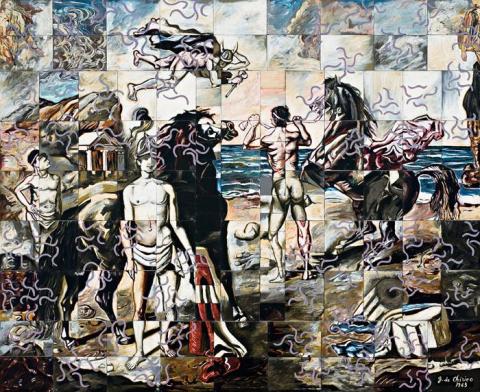LA CITTA DI RIGA, 1987
Imants Tillers
oil stick, gouache and synthetic polymer paint on 119 canvas boards
279.5 x 343.0 cm overall
inscribed lower right: ‘G. de Chirico 1963’ numbered verso 16593 - 16711
Yuill/Crowley Gallery, Sydney
Private collection, Sydney
A Life of Blank, Works by Imants Tillers, University of Tasmania Plimsoll Gallery, February – March 1992 and touring to Monash University Gallery, Orange Regional Gallery, Queen Victoria Museum and Art Gallery, Launceston.
Slayter, J. and Holmes, J., A Life of Blank, Works by Imants Tillers, University of Tasmania, Hobart, 1992, p. 14 (illus.)
Curnow, W., Imants Tillers and the 'Book of Power', Craftsman House, G+B Arts International, Sydney, 1998, pl. 35 (illus.)
Since his first solo exhibition in 1973, Imants Tillers has received widespread acclaim as one of the most influential exponents of conceptual painting in this country. From his investigations during the 1970s into seriality, visual displacement and found imagery (initiated primarily as a result of his involvement in Christo's controversial wrapping of the Little Bay coastline, Sydney in 1968-69), to the appropriation paintings of the following two decades, he has been concerned fundamentally with issues of origins and originality, interaction of self and other. Nowhere is this abiding preoccupation with presence and absence of self-encapsulated more explicitly than in his unique conception of his oeuvre as a canvasboard system. This is exemplified by Citta di Riga, 1987, in which boards unfold from one work to another to form an encompassing whole, variously referred to as the 'Book of Power.'
A lifelong project by Tillers, in which he derives all of his imagery from reproductions of the work of other artists and paints them on consecutively numbered canvas boards, the 'Book of Power' thus offers a point of identification - both relevant to and beyond the self = with a web of wider connections. In the present work for example, by appropriating two reproductions of Giorgio de Chirico's Ippolito e i Suoi Compagni, 1963, one colour and one black and white, Tillers encourages his audience to view, read and understand his work through a complex series of systems. Introducing doubt to traditional values such as 'originality', the artist not only highlights the value and authority of the reproduction in the postmodern era, but magnifies issues of cultural dislocation.
Born in Sydney of Latvian heritage, Tillers is acutely conscious of a detachment from both Australian culture and that of his parents, of 'occupying a zone where I don't particularly fit into either...'1 In his often ambiguous response to his own cultural inheritance, Tillers no doubt felt strong affinities with the conundrum of de Chirico's hybrid identity '...his early Greek education, his Middle-European culture picked up in Munich and his French intellectualism.'2 With de Chirico's belief in clairvoyance and recognition of apparently coincidental occurrences across time and place, the Italian master of enigma and chance afforded a valuable point of departure for Tillers' own metaphysical ideas. Ultimately however, while deciphering the myriad of references that punctuate Tillers' works is always rewarding, it is arguably more meaningful to experience the work as a whole. As the artist himself elucidates, '...issues of locality and identity have become uppermost in my mind and have made their presence in my recent work, not as literal representations- but as evocations, through text and other layered visual elements.'3
1. Imants Tillers cited in Curnow, W., Imants Tillers and the 'Book of Power' Craftsman House, G+B Arts International, Sydney, 1998, p. 126
2. dell'Arco, M., 'The Last Individualist' cited in Hart, D. (ed.), Imants Tillers: One World Many Visions, National Gallery of Australia, Canberra, 2006, p. 37
3. Tillers cited in Hart, ibid.
VERONICA ANGELATOS
